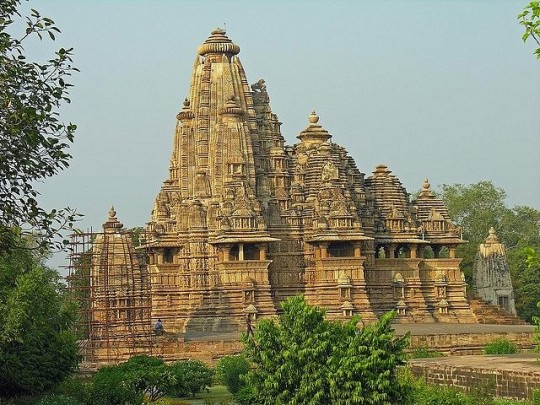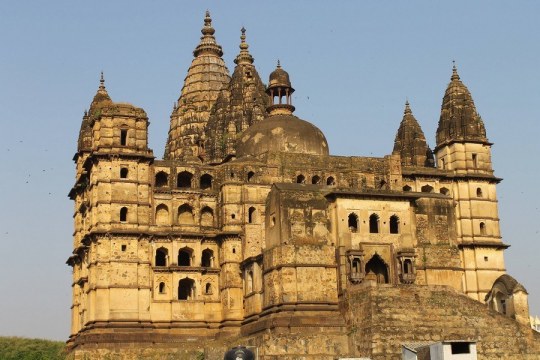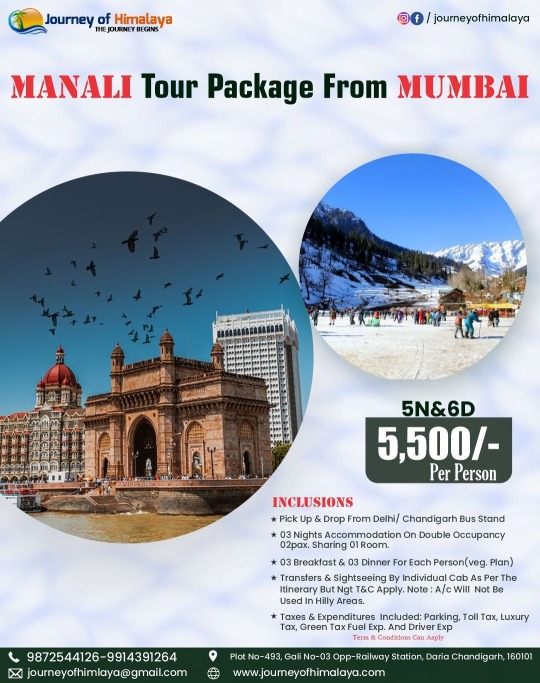#gurjara-pratihara
Explore tagged Tumblr posts
Text
1 note
·
View note
Photo

Khajuraho
Khajuraho was an ancient city in the Madhya Pradesh region of northern India. From the 10th to 12th century CE it was the capital of the Chandella kings who ruled Bundelkhand. Despite Khajuraho's once great reputation as an important cultural centre there are no surviving non-religious buildings, but the presence of 35 Hindu and Jain temples make it one of the most significant historical sites in India today and worthy of its name given by the 11th century CE Muslim historian Abu Rihan Alberuni as 'the City of the Gods'. Khajuraho is listed by UNESCO as a World Heritage Site.
Architectural Highlights
Most of the temples at Khajuraho were built using sandstone but four also used granite in their construction. In the latter group is the Chaunsat Yogini (64 tantric goddesses), built c. 875-900 CE, which has 64 shrine rooms arranged around a rectangular courtyard. Next in the site's development came the Lalguan Mahadeva, Brahma, and Matangesvara temples which are all quite plain in design and decoration compared to the later temples.
The majority of temples at Khajuraho were constructed between 950 and 1050 CE and are either Hindu (Saiva or Vaisnava) or Jain. The most famous is the Kandariya Mahadeo built in the early 11th century CE and dedicated to Shiva. The more or less contemporary Laksmana temple was built in 954 CE by King Dhanga (r. 950-999 CE) to celebrate independence from the Gurjara-Pratihara rulers and has a similar layout and exterior to the Kandariya Mahadeo. So too does the Visvanatha temple (c. 1002 CE) which was designed by Sutradhara Chhichchha. Both temples have shrines at each corner of their terrace platforms. The Laksmana was dedicated to Vishnu and its terrace is of particular note as it carries a narrative frieze running around all four sides: Elephants, warriors, hunters, and musicians form a procession watched by a ruler and his female attendants.
Other notable temples at the site include the single-towered Caturbhuja and Vamana, the squat Matulunga, and the rectangular, more austere Parshvanatha Jain temple with its unique shrine added to the rear of the building (c. 950-970 CE). Probably the latest temple at Khajuraho is the Duladeo which was built on a star-plan.
Continue reading...
61 notes
·
View notes
Text

Vedic Temples 'वैदिक मंदिर' ॐ
Sculptures near Teli ka Mandir, Gwalior Fort, Madhya Pradesh, INDIA built during 8th-9th century CE in Gurjara-Pratihara Emire (mid-8th century CE - 1036 CE). [660 x 976]
5 notes
·
View notes
Text

I posted 1,003 times in 2022
634 posts created (63%)
369 posts reblogged (37%)
Blogs I reblogged the most:
@shilabalika
@navaratna
@savlon-bhoi
@suvarnarekha
@navratri-celebrations-2k22
I tagged 736 of my posts in 2022
Only 27% of my posts had no tags
#yedipanti - 167 posts
#desiblr - 64 posts
#legacies - 48 posts
#bollywood - 46 posts
#india - 28 posts
#anonnie - 23 posts
#hindublr - 20 posts
#navratri - 18 posts
#jedben - 18 posts
#quotes - 18 posts
Longest Tag: 131 characters
#when things are somewhat aware to us but pondering on them carefully makes us realise how wonderfully divine and virtous truly are!
My Top Posts in 2022:
#5
Toni: Valentine’s day is just a consumerist holiday that holds no real value other than drive people insane buying heart shaped chocolates for their significant others and pos-
Shelby: I wrote you a poem.
Toni, already crying: You did?
153 notes - Posted April 9, 2022
#4
just- the parallels got to me like ✨


See the full post
215 notes - Posted June 20, 2022
#3
removing mughal chapters won't do shit, cbse. they were a part of our history and we will study them. want to make amends? well first stop glorifying them and include medieval history about marathas, ahoms, rajputs, cholas, rashtrakutas, chalukyas, gurjara pratiharas, vijaynagara and many more empires.
252 notes - Posted May 3, 2022
#2
भारतीय वास्तुकला ✨


See the full post
265 notes - Posted April 19, 2022
My #1 post of 2022
people have these aesthetic book shelves, library and shit meanwhile here i am downloading my 789th illegal pdf/epub.
3,575 notes - Posted July 5, 2022
Get your Tumblr 2022 Year in Review →
#tumblr2022#year in review#my 2022 tumblr year in review#your tumblr year in review#that number 1 post makes me so proud lmao
6 notes
·
View notes
Photo

Empire Gurjara-Pratihâra
Les Gurjara-Pratihâra, ou plus simplement les Pratihâra (VIIIᵉ -XIᵉ siècles de notre ère) exercèrent leur influence sur l'ouest et le nord de l'Inde. Cette dynastie vit sa puissance s'accroître sous Nâgabhata I (r. de 730 à 760) qui réussit à repousser les envahisseurs arabes. Bhoja ou Mihira Bhoja (r. vers 836-885) est le roi le plus connu de cette dynastie. Les Pratihâra étaient principalement connus pour leur soutien à l'art, à la sculpture et à la construction de temples, ainsi que pour leurs guerres incessantes contre des puissances contemporaines telles que les Pala (VIIIᵉ siècle - XIIᵉ siècle) de l'Inde orientale et la dynastie des Rashtrakuta (VIIIᵉ siècle - Xᵉ siècle) de l'Inde méridionale.
Lire la suite...
0 notes
Text
Pratihara Architecture in India: A Testament to Grandeur and Innovation.
In the vast landscape of Indian architecture, the Pratihara style stands out as a testament to the grandeur and artistic prowess of the bygone era. Originating in the 8th century under the reign of the Gurjara-Pratihara dynasty, this architectural style flourished primarily in the western regions of India, leaving behind a legacy of intricate designs and striking structures that continue to captivate historians and architects alike.

0 notes
Text
INDIA , THAT IS BHARAT -A HISTORICAL PERSPECTIVE, #BHARAT
THE GURJARA-PRATIHARA DYNASTY The GURJARA-PRATIHARA DYNASTY , instrumental in containing ARAB armies moving east of the INDUS RIVER , ruled much of …INDIA , THAT IS BHARAT -A HISTORICAL PERSPECTIVE, #BHARAT

View On WordPress
0 notes
Text
















91) Beludżowie, Baloch, Baluch, بلۏچ, Balòc, Белу́джи, балоч – lud indoeuropejski pochodzenia irańskiego. Zamieszkują Pakistan, Iran, południowy Afganistan, Oman, Turkmenistan i Tadżykistan. Są narodem bez własnej państwowości, zamieszkują historyczny region zwany Beludżystanem. Posługują się językiem beludżi, wyznają islam sunnicki. W VII w. zostali wyparci przez Arabów z pierwotnych siedzib położonych nad Morzem Kaspijskim. W 971–972 roku pokonał ich Adud al-Dawla z arabskiej dynastii Bujidów. W XVI w. Beludżowie utworzyli kilka feudalnych księstw. W XVII wieku plemienny przywódca Mir Hasan dał się poznać jako pierwszy „chan Beludżów”. Jego następcą od 1666 roku był Ahmad I, który założył Chanat Kalat, który wszedł w 1839 roku w skład Indii Brytyjskich, a później od 1948 roku w skład Pakistanu utrzymując do 1955 roku autonomię. Pozostałe terytoria zajmowane przez Beludżów weszły w skład Iranu. W 1958 wybuchło krótkotrwałe powstanie mające na celu odzyskanie przez Chanat Kalat odebranej autonomii. Beludżowie zajmują się głównie półosiadłym lub osiadłym pasterstwem (wielbłądy, owce, kozy), częściowo także uprawą zbóż. Lud ten ma bogate tradycje rzemieślnicze, przede wszystkim haftu i wyrobu dywanów. Dywany te słyną w całym świecie. System plemienny oparty na więzi terytorialnej jest skomplikowany. Dziedziczni wodzowie kierują plemionami, złożonymi z podplemion i rodów. Na przestrzeni wieków styl życia Beludżów zmienił się w niewielkim stopniu. Tradycje i obyczaje dzielą ze spokrewnionym ludem Pasztunów zamieszkujących Afganistan.
Koczownicza, pasterska, zachodnio-irańska grupa etniczna pochodząca z regionu Beludżystanu w Azji Południowej i Zachodniej, obejmującego kraje Pakistanu, Iranu i Afganistanu. Społeczności diaspory Beludżów istnieją także w sąsiednich regionach, m.in. w Azji Środkowej i na Półwyspie Arabskim. Asymilacja plemion innych niż Beludżów do systemu plemiennego Beludżów była głównym zjawiskiem w całej historii ludu Beludżów, a obecnie znaczna populacja Beludżów ma zróżnicowane pochodzenie. Większość Beludżów mieszka w Pakistanie. Około 50% całej populacji Beludżów mieszka w pakistańskiej prowincji Beludżystan, 40% w Sindh, a znaczna, choć mniejsza liczba, w pakistańskim Pendżabie. Stanowią prawie 3,6% całkowitej populacji Pakistanu i około 2% populacji Iranu i Afganistanu. Dokładne pochodzenie słowa „Baloch” jest niejasne. Według historyka beludżjskiego Naseera Dashti (2012) nazwa tej grupy etnicznej wywodzi się od „Balaschika” zamieszkującego Balasagan, pomiędzy Morzem Kaspijskim a jeziorem Wan na terenie dzisiejszej Turcji i Azerbejdżanu, który prawdopodobnie wyemigrował do Beludżystanu w okresie czasy sasańskie. Uważa się, że pozostałości pierwotnej nazwy, takie jak „Balochuk” i „Balochiki”, są nadal używane jako nazwy etniczne w Beludżystanie. Niektórzy inni autorzy sugerują wyprowadzenie z sanskrytu słów bal, oznaczających siłę i och, oznaczających wysoki lub wspaniały. Najwcześniejszą wzmianką o Beludżach w sanskrycie może być inskrypcja w Gwalior władcy Gurjara-Pratihara Mihira Bhoja (r. 836–885), która mówi, że założyciel dynastii Nagabhata I odepchnął potężną armię Valacha Mlecchasa, co tłumaczy się jako „cudzoziemcy Beludżów”. przez D. R. Bhandarkar. Armia, o której mowa, to armia kalifatu Umajjadów po podboju Sindh.
Irańczycy o tradycyjnej kulturze koczowniczej i rozwiniętych podziałach plemiennych, posługujący się językiem północno-zachodniej podgrupy irańskiej grupy języków. Zamieszkuje jałową południowo-wschodnią część płaskowyżu irańskiego od wybrzeży Morza Arabskiego w głębi lądu, podzieloną między Pakistan (prowincja Beludżystan), Iran (Sistan i Beludżystan) oraz południowy Afganistan. Obecność plemion Beludżów jest również znacząca w Zjednoczonych Emiratach Arabskich i Omanie. Całkowita liczba zbliża się do 9 milionów osób. Ze względu na religię są muzułmanami madhabu Hanafi.
0 notes
Text
The Fragrant Legacy of Kannauj Attar: A Perfume Beyond Time
Introduction
In the heart of Northern India, nestled along the banks of the River Ganges, lies the ancient town of Kannauj. While it may not be the most renowned tourist destination, Kannauj boasts a history that is deeply intertwined with the world of fragrance. For centuries, this quaint town has been the epicenter of attar production, earning its reputation as the perfume capital of India. In this blog, we will explore the enchanting world of Kannauj attar, a fragrance tradition that has stood the test of time.
A Fragrant History
Kannauj's legacy as a hub of perfumery dates back over a thousand years. Its aromatic history is believed to have begun during the 7th century when the town served as the capital of the Gurjara-Pratihara dynasty. Kannauj's strategic location on ancient trade routes made it a melting pot of diverse cultures, enabling the synthesis of various fragrant traditions.

The Craft of Attar Making
At the heart of Kannauj's perfume industry lies the art of attar making. Attar, also known as ittar, is a traditional form of perfume derived from natural ingredients, mainly flowers, herbs, and spices. The process is a labor of love, involving meticulous care and attention to detail.
Harvesting: The process begins with the careful collection of fragrant natural ingredients like roses, jasmine, sandalwood, and more. Kannauj's favorable climate makes it the perfect location for cultivating these aromatic plants.
Steam Distillation: Once harvested, the petals, roots, or seeds are subjected to steam distillation. This delicate process involves passing steam through the fragrant material to release their essential oils.
Blending and Aging: The essential oils are then blended together, creating complex and unique fragrances. The attars are aged in clay pots or glass containers to allow the aroma to mature and deepen over time.
Bottling: After the attar has aged to perfection, it is bottled in ornate, handcrafted containers, adding to the allure of Kannauj attar.
A Fragrance for Every Occasion
Kannauj attar is renowned for its versatility. The town's perfumers have mastered the art of crafting a wide range of fragrances to suit every occasion and personality. From delicate floral notes that capture the essence of spring to rich, musky scents that evoke warmth and sensuality, there is a Kannauj attar for every mood and moment.
Rose Attar: The delicate and romantic scent of Kannauj's rose attar is perfect for special occasions and is often associated with love and beauty.
Sandalwood Attar: With its warm and woody notes, sandalwood attar is cherished for its calming and meditative properties.
Jasmine Attar: The intoxicating aroma of jasmine attar is a symbol of sensuality and luxury, making it a popular choice for perfumes and cosmetics.
A Sustainable Tradition
In a world increasingly conscious of environmental impact, Kannauj attar holds a unique place as a sustainable and eco-friendly fragrance. The use of natural ingredients and traditional distillation methods minimizes the carbon footprint associated with modern synthetic perfumes.
Additionally, Kannauj attar is largely produced by local artisans and families, supporting the economy of this ancient town and preserving its rich tradition.
Conclusion
Kannauj attar is more than just a fragrance; it is a testament to the enduring power of tradition and the beauty of simplicity. In an age of mass-produced synthetic scents, this fragrant art form continues to flourish, proving that the allure of natural, handcrafted perfumes is timeless.
The next time you seek a fragrance that transcends time and trends, consider exploring the enchanting world of Kannauj attar. With its rich history, diverse range of scents, and commitment to sustainability, Kannauj attar remains a true olfactory treasure, inviting you to experience the magic of fragrances that have graced the Indian subcontinent for centuries.
0 notes
Text


It is an ancient #temple built during the reign of the Gurjara Pratihara dynasty in 875 AD Orcha. Originally it was a temple of #LordRama, but later on, it was dedicated to #LordVishnu. You can spot numerous lotus emblems and other religious symbols throughout the temple.
#Chaturbhuj Temple in orcha#travel agent in delhi#tour operator in delhi#golden triangle package#travel agency in india#travel agency in delhi#travel agents in delhi#madhya pradesh tour package
0 notes
Text
Gurjara Pratihara Dynasty
Context: Following the unveiling of the statue of 9th-century king Mihir Bhoja as ‘Gurjar Pratihar Samrat Mihir Bhoja’ by district party leaders, leaders in Haryana’s Kaithal expressed their protest by offering to resign. The controversy surrounding Mihir Bhoja’s lineage has arisen before in Bihar and Uttar Pradesh, with both Gurjaras and Rajputs laying claim to his belonging in their respective…

View On WordPress
0 notes
Text
Manali:- Hub Of Adventure Spot
India is filled with such incredible road trips that offer an amazing yet offbeat travel experience! Manali is one of them. Manali lies in the North of Kullu Valley. The valley is often referred to as the ‘Valley of the Gods’. Manali is a hub of adventure sports and activities. From parasailing and paragliding to white water rafting, you can find everything here. Solang Valley is one of the prominent places in the Himachal Tour Packages from Mumbai to enjoy some adventure sports. The scintillating hill-stations of Kullu and Manali are waiting to surprise you with their irresistible beauty and charm. Kullu and Manali combine picturesque surroundings with vibrant culture and exciting adventure activities. Visit here if you want to experience the raw beauty of nature.

Places To Visit In Manali:-
Kothi Village:-
Kothi village is one of the most scenic places to be visited in Manali. The beautiful valley view is worth watching. This village is situated in the foothills of the Rohtang Pass and boasts an altitude of 2500 meters. The place offers a superb view of the Beas River as it flows through a narrow gorge. Frequently used by many film crews for shoots, there’s no better place in Manali that satisfies the nature-lover in you. The village also has a temple enshrining the local deity – Goddess Shuwang Chandika. One can get a beautiful view of the snow-capped mountain peaks, River Beas and the glaciers. The breathtaking sight is worth witnessing and capturing in photographs in Mumbai To Manali Tour Package.
Gauri Shankar Temple:-
Located right below the Naggar Castle, the temple has its origins dating back to the 12 century and stands as a tribute to Lord Shiva. It has been deemed a protected monument and is adored for its Shikara styled architecture. Featuring a dome-shaped top, square-shaped base and interiors that have been exquisitely decorated. The meticulously carved structure also attracts researchers, architecture freaks and history buffs. Surrounded by lush greenery and overlooking the Beas River, this temple is considered to be the last monument of the Gurjara-Pratihara dynasty. Its beauty is unmatchable with a beautifully decorated massive shikhara in Manali Tour Package from Mumbai.

Malana:-
A historic Indian village in the state of Himachal Pradesh, Malana is shadowed by the peaks of Deotibba and Chanderkhani. It is a tiny village amidst the lush green and shimmering snow-capped mountains of the Parvati valley, 9500 ft above sea level. The village positions itself on an isolated plateau on the banks of the Malana River. The people of Malana follow their own distinct lifestyles and are extremely strict when it comes to following their customs. Their dressing sense, the kind of food they eat, the festivals they celebrate, the way those festivals are celebrated and more reflect the vibrant culture and tradition that is quite unique to the place. The residents here are speakers of the autochthonous language Kanashi. Explore the naturistic view in Manali Couple Tour Package from Mumbai.
0 notes
Photo

Nagabhata I, king of the Gurjara-Pratihara dynasty, who defeated Arab invaders & prevented them from crossing the Sindh region. (at Tiruchchirappalli) https://www.instagram.com/p/CpQDz95v8qtJ-2-OXNs9qqpldsxgBfiyTVmdVE0/?igshid=NGJjMDIxMWI=
0 notes
Photo

|| BATESHWAR || Bateshwar Group of Temples is located in Morena district of Madhya Pradesh. Situated just 35 km away from Gwalior it is also known as Batesara. The name Bateshwar is probably derived from Bhooteshwar, another name for Bhagwan Shiva. • The Bateshwar Group of Temples belongs to the Gurjara – Pratihara era. The Gurjara – Pratihara was one of the most formidable dynasties in the post-Gupta era. They ruled over most of northern and central India from mid-8th to 11th centuries. Claiming descent from Ram Chandra’s younger brother Lakshmana, the most eminent ruler of this dynasty was Mihir Bhoja. The Pratiharas were engaged in the long-drawn Tripartite Struggle with the Palas and Rashtrakutas for dominance of northern India. 📸 Credit thefloatingpebbles (IG) #TeamLostTemples #ancient #positivevibes (at Bateshwar group of Temples) https://www.instagram.com/p/Cmhr_kvSffA/?igshid=NGJjMDIxMWI=
0 notes
Photo

Surasundari - the celestial beauty
Panel outside the Ambika Temple, Jagat
10th Century CE, Gurjara Pratihara Era
31 notes
·
View notes